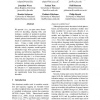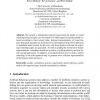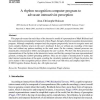3051 search results - page 7 / 611 » Learning Internal Representations |
NN
2002
Springer
13 years 7 months ago
2002
Springer
Recognition-by-components is one of the possible strategies proposed for object recognition by the brain, but little is known about the low-level mechanism by which the parts of o...
ACL
2010
13 years 5 months ago
2010
We present cdec, an open source framework for decoding, aligning with, and training a number of statistical machine translation models, including word-based models, phrase-based m...
ICANN
2010
Springer
13 years 8 months ago
2010
Springer
We present a biologically inspired neural network model of visual orienting (using saccadic eye movements) in which targets are preferentially selected according to their reward va...
KES
1998
Springer
13 years 11 months ago
1998
Springer
An agent must acquire internal representation appropriate for its task, environment, sensors. As a learning algorithm, reinforcement learning is often utilized to acquire the rela...
COGSCI
2004
13 years 7 months ago
2004
This paper advocates the main ideas of the interactive model of representation of Mark Bickhard and the assimilation/accommodation framework of Jean Piaget, through a rhythm recog...



